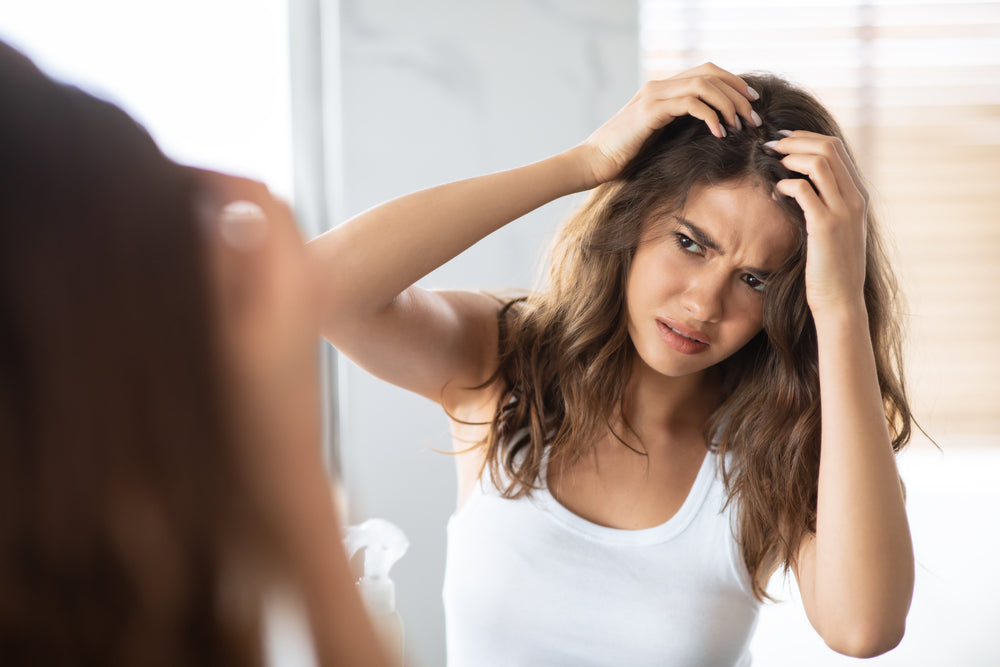
Goodbye Oily Scalp, Hello Healthy Hair

If you're anything like us, months of hunching down at home mean that you've probably gotten used to washing your hair less often.
Besides, your boss couldn't exactly see your oily roots via Zoom, and the next-door neighbor who checks up on you is often more concerned about your unwashed pajamas than the state of your locks.
However, as normalcy continues to return, we're likely to be venturing into the big wide world a bit more. Whether it's popping into the office every now and then or going to dinner with the girls, chances are, you're going to have to leave the lockdown aesthetic in the past. In other words, you're going to have to wash and shampoo your hair more often, which inevitably translates to an oily scalp (we'll tell you more on this below).
So, what now? How do you save yourself the embarrassment of unsightly, oily, dandruff-ridden hair?
No need to panic. The hair experts at RevAir have got your back, like always. In this post, we'll talk about oily scalp and tell you what you can do to attain a healthy, fine-looking scalp. Shall we?
Oily Scalp: Your Hair's Worst Nightmare
Oily hair, don't care? Yeah, right. If you have an oily scalp (like some of us do), you know how frustrating it can be to have hair that feels clean and bouncy one minute and dirty the next.
The good news is, there's some scientific explanation to it.
The reason hair gets oily is that sebaceous glands in your scalp produce excess sebum, which trickles down the hair shaft. The sebum is then absorbed by the roots and too much of it can create an oily appearance.
The oil in itself isn't bad for the hair. In fact, it makes hair healthy, lustrous, and strong. However, too much of this oil can cause a build-up that leaves your hair excessively slick, sticky, and dirty.
And that's just Day 1.
All hell breaks loose when a greasy, irritated, or otherwise unhealthy scalp is left unattended for several days. When this happens, you'll (literally) hear your scalp complaining of:
- Dandruff: This natural, yeast-like fungus might be harmless, but once it grows out of control, you'll certainly feel its presence. By presence, we mean constant inflammation, flaking, and itching.
- Suffocation: Continued accumulation of dead skin and oil at the hair roots will leave your scalp gasping for air. But that's just the tip of the iceberg. A suffocating scalp produces thin, damaged hair as well as embarrassing white flakes that make you question your beauty.
- Hair loss: Excess oil can clog pores on your scalp, which can prevent your hair follicles from growing normally. As a result, you might experience rapid hair loss.
That said, excessive sebum production might not be the only reason your scalp is oil-prone. There could be more to it than meets the eye.

Have a Perpetually Oily Scalp? It Didn't Happen By Accident
The temptation when you have oily roots is to wash your hair more often. Big mistake! Washing your hair every day can actually contribute to oily roots.
That's because once you've trained your hair into a regular wash, it can feel oily and sticky if you skip a day without scrubbing. It's the same as over-cleansing your skin and stripping it of its natural oils; the more you clean your hair, the more oil your scalp produces to compensate.
Of course, it's not just about how you're washing your hair, but how often you are shampooing it and the kinds of shampoos you're using. Harsh shampoos strip the scalp of its natural oils, especially if they have a basic pH. These products open what should be a closed hair cuticle, then the water evaporates out, and dryness follows. Sebum-producing glands don't like it when your scalp is devoid of moisture, so they immediately kick into overdrive.
Other factors can contribute to an ever-oily scalp, too. If you have both an oily face and scalp, your genetic code is likely at play. Alongside genetics, stress, hormones, and humid weather can also make your scalp overly oily.

Maintaining a Healthy Scalp: Here's How You Train Your Scalp (and Hair) to Be Less Oily
In this section, we're going to help you get to the root of the problem—literally. Some of these hacks and tips might seem obvious, but they're not. Ignore them at your own (and your scalp's) peril.
Exfoliate, Exfoliate, Exfoliate!
It's totally OK to exfoliate the scalp area every once in a while. After all, you don't want gunk and debris to build up underneath those beautiful strands. For an exfoliating product, look for something consisting of finely ground textures such as crushed shells or salt.
What to do (actual steps):
- Soak your scalp in water
- Apply the exfoliant to the entire scalp area
- Use small, circular motions with your fingers to gently massage the exfoliant into your scalp—just as you would with a facial exfoliant.
The key here is to be gentle but thorough. Before rinsing off the product, leave for a couple of minutes.
Need a nutrient-rich mist to detangle your hair immediately after rinsing? Our RevAir Bright Spot Detangle & Shine Spray can do that, and a lot more.
- Apply Dry Shampoo, But With a Twist.
When you first skip the chemical-laden shampoos, your scalp will look oily for the first few washes as it adapts to producing less oil. Your not-so-secret weapon until your scalp adjusts? Dry shampoo.
If dry shampoo hasn't worked for you in the past, you're probably not using it correctly.
The best way to apply dry shampoo:
- Brush your hair first
- Shake the can of dry shampoo
- Mist your hair just on the roots while keeping the bottle a few inches away from your scalp
- Distribute the product evenly by brushing out your hair again
You might be tempted to skip brushing post-spritz. Don't do it. The product can clog pores on your scalp area and result in the overproduction of sebum.
For the days your oily scalp will need more love and attention, we recommend two simple hairstyles—flirty curls and a messy ponytail.
To make the ponytail, mist dry shampoo onto your scalp evenly. Next, use your fingertips to brush your hair back and create a natural texture. Finish it off by securing the ponytail with a hair tie.

Curls work by making oily hair look less flat. When your hair gets oily, it tends to get flatter. So wash it first, towel dry, and then fluff it up. Insert your hair into the RevAir Hair Dryer wand, up to the scalp. Hold the wand up to or near the scalp. When dry, remove and repeat, section by section, until complete. Then section off your Rev'd hair, wrapping sections around a curling iron to create loose, flirty curls. Finish with texturizing or sea salt spray.
Use Styling Products in ModerationTo avoid making the hair even more greasy, use products such as hair wax sparingly, as these can further weigh down hair.
And don't apply to the roots—just the lengths and ends. Excessive hairspray can also make the scalp itchy and the strands greasy. A few sprays will do. Also, exercise caution when using hair oils: these are for dry ends only.
Ditch ConditionerIt doesn't matter whether you have oily or dry scalp; applying conditioner to your scalp is a big no-no.
Conditioner makes your scalp oilier, promotes hair fall, and accelerates bacterial growth. But that doesn't mean you shouldn't apply conditioner at all.
Apply it only to the tips of your tresses and work your way upwards. Stop exactly 2 inches away from the scalp.
Make a Hair-Washing ScheduleIt might sound a little overambitious, but a hair-washing schedule can bring you one step closer to attaining a healthy scalp.
Certain times of the day are better for hair washing than others, such as after a workout or first thing in the morning. Fill your timetable with these first.
Night hours are not ideal for washing your hair as it might look greasy again by morning. So keep these hours off your washing schedule. However, if it's a must that you wash your hair at night, keep your towel close and your RevAir Dryer closer.
Maintain Blood Circulation to the ScalpThis tip might look farfetched, but it's just as important. Proper blood circulation ensures that your scalp gets the nutrients and oxygen it needs to remain healthy. A healthy scalp translates to long, healthy hair follicles (and who doesn't love long tresses?)
What to do:
- Using coconut oil, castor oil, or sweet almond, massage your scalp thoroughly but gently. Massaging in itself enhances blood circulation, while these oils promote healthy hair growth.
- Essential oils like thyme, lavender, and rosemary are extremely beneficial for blood circulation. So add them to your vanity ASAP!
- Indulge in an intensive breathing exercise like pranayama in yoga. Such exercises boost oxygen supply to the entire body, including the scalp.
UV rays are arguably your hair and scalp's biggest enemy, so you need to protect yourself when you're out in the sun.
Rocking a protective style is a good starting point, but if you really want to attain healthy hair all-round, you have to stop sidelining your scalp. After all, it takes a healthy scalp to grow healthy hair. Other than the sun's cruel rays, harsh chemicals, and intense temperatures can also wreak havoc on your scalp.
How to protect your scalp:
- Wear a hat or scarf when sunbathing, after taking a dip, and while taking a stroll.
- Avoid spending time outside in the extreme cold.
- Ditch hair products that irritate your scalp and exacerbate existing conditions. Those with toxic ingredients like sulfates, parabens, silicones, and coal tar should be a no-go zone from here on out.
To Wrap It All Up…
As we've seen throughout this blog, fighting an oily scalp is pretty easy. We've done our part by covering the ins and outs of this topic, so it now comes down to you. How far are you willing to go to fight oily scalp and achieve healthy hair, top to bottom? We hope your answer is: all the way! Follow the hair care tips on here, and you'll surely become an all-around beauty babe. Thank us later!
Reach out to us today to learn more about caring for your precious strands. We're always looking to lend a hand!















